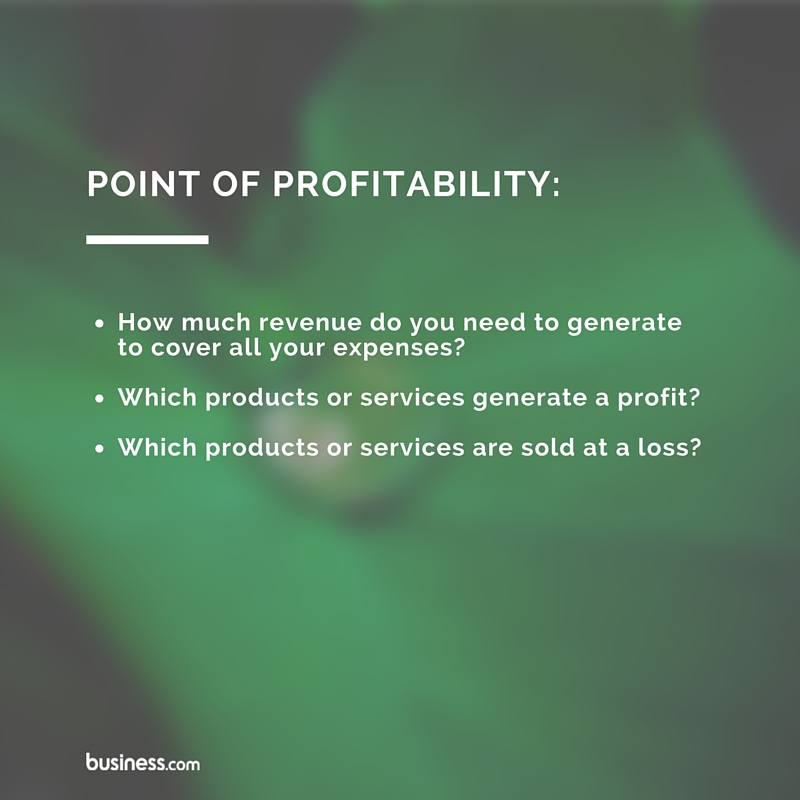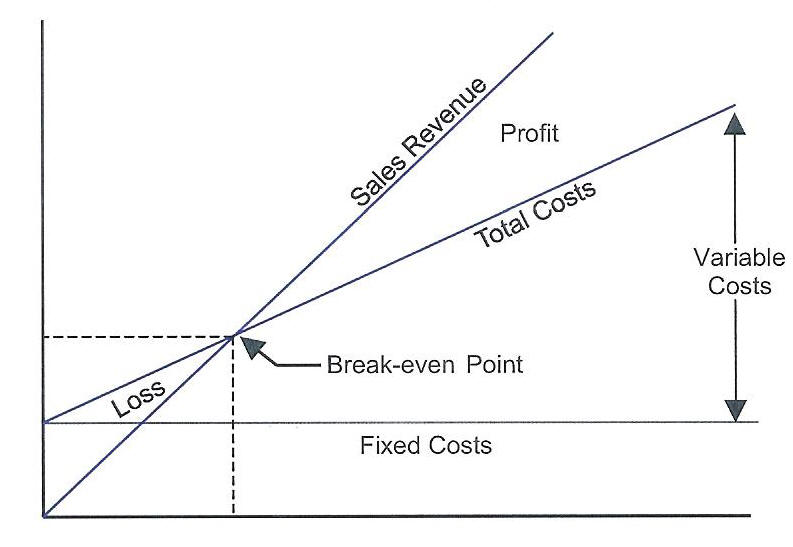The break-even analysis is one tool that every entrepreneur should use in their financial planning. It helps you understand your business's revenue, expenses and cash flow – which is critical to keeping your doors open and your business profitable. Read on to learn more about what a break-even analysis is and how this essential form of financial planning helps business owners make informed decisions.
What is a break-even analysis?
A break-even analysis is a financial tool that helps you determine at which stage your company, service or product will be profitable. It is a financial calculation used to determine the number of products or services a company must sell to cover its expenses, especially the fixed costs.
Here's an example of the elements that go into a break-even analysis:
- Fixed costs: These are the costs that stay the same no matter how much the business sells, also referred to as overhead costs. They include utilities, bills, salaries and wages, rent, and insurance.
- Variable costs: Variable costs are based on a business's sales. They can include additional labor from independent contractors, materials and payment processing fees.
- Average price: This is the average amount you will charge for your products and services.
What is the break-even point formula?
Taken together, these elements create a formula known as the break-even point formula. It is a relatively simple calculation, but it is critical in planning for profitability.
Fixed Costs / (Average Price - Variable Cost) = Break-Even Point
The term "break-even" refers to a situation where you are neither making nor losing money, but all of your costs have been covered. With a break-even analysis, you can determine when your company will generate enough revenue to cover its expenses and earn a profit. The same holds true for a particular product or service. This data is often used for financial projections.
Examples of break-even analysis
Here are two examples of the break-even point formula.
Example 1
The price of one of the products you sell is $100. Your total fixed costs are $10,000 per month, and the variable cost is $50 per product. The formula to calculate how many products you must sell to break even would look like this:
$10,000 / ($100 - $50) = 200
Based on the formula, you would need to sell 200 products to cover your costs, effectively breaking even. To be profitable, you would have to sell at least 201 products.
Example 2
In this example from the Corporate Finance Institute, a water company has total fixed costs of $100,000. The variable costs of making one bottle of water is $2 per unit, and each bottle is sold for $12. Using the break-even analysis formula, you can see that the company must sell 10,000 bottles to recoup its costs and 10,001 bottles to begin earning a profit:
$100,000 / ($12 - $2) = 10,000
Editor's note: Looking for a small business loan? Fill out the questionnaire below to have our vendor partners contact you about your needs.
Why is a break-even analysis important?
A break-even analysis informs you of the bare minimum performance your business must meet to avoid losing money. It also helps you understand at which point you'll generate profits so you can set production goals accordingly.
You can use this information when your business is in the planning stages to determine whether your idea is feasible or not. Then, once your business is established, you can use a break-even analysis to develop direct cost structures and to identify opportunities for promotions and discounts.
While there is a lot to know about conducting a break-even analysis, let's focus on the three most common uses.
1. It helps you identify the point of profitability.
A business that doesn't turn a profit could take a turn for the worse at any time. This is why every company needs to focus on its point of profitability. Ask yourself these questions:
- How much revenue do I need to generate to cover all my expenses?
- Which products or services generate a profit?
- Which products or services are sold at a loss?

A company's goal is to become profitable as soon as possible. To ensure that you are on the right track, it is necessary to focus on your numbers upfront. If you don't calculate the break-even points for your products or services, you risk not generating a profit (or not as much of a profit as you believed you would).
2. It ensures that you properly price a product or service.
When most people think about pricing, they primarily take into account how much their product costs to create and fail to consider overhead costs – underpricing their products as a result. Finding your break-even point will help you price your products correctly. You will know where you need to set your margins to generate the right amount of revenue to break even and begin turning a profit.
If you offer only a couple of products or services, determining your break-even point is simple. It becomes more challenging as your service offerings and production increase.

Image via Business Tool Pro
As you determine your break-even point for a product or service, ask yourself the following questions:
- What is the total cost?
- What are the fixed costs?
- What are the variable costs?
- What is the total variable cost?
- What is the cost of any raw materials?
- What is the cost of labor?
Last but not least, you should ask yourself, "What adjustments can I make to lower the cost of manufacturing or generate the end result I envision?" For instance, you may be able to source some products from a cheaper distributor, or perhaps make some changes to your hiring process to save on labor costs.
3. It gives you the information you need to implement the best strategy moving forward.
Using your break-even analysis, you can create a strategy for the future. If your business's profitability is determined by the success of one or more products, the break-even point for each product provides a timeline for the company, which can help you implement a better overall financial strategy that fits the projected costs and profits.
This analysis can also help you determine ways to speed up your company's break-even point, such as reducing your overall fixed costs, reducing the variable costs per unit, improving the sales mix by selling more of the products that have larger contribution margins, and increasing the prices (as long as it doesn't cause the number of units sold to decline significantly).
When should I use a break-even analysis?
There are many situations in running a business where a break-even analysis comes in handy. According to Rick Vazza, a CFA and CFP and the president of Driven Wealth Management, you should use a break-even analysis to answer the following questions about your business:
- How much of my product or service do I need to sell per month?
- How much volume do I expect to sell?
- What price makes those figures match my break-even calculation?
- What price allows me to generate a reasonable profit?
Your goal is to get an accurate look at what your profit, net cash flow and finances will be.
"It's much easier for people to decide whether they can beat that minimum than guessing how many sales they may make," said Rob Stephens, founder of CFO Perspective.
Here are three times when you should consider performing a break-even analysis.
If you are expanding your business
Stephens suggests using a break-even analysis to get a reality check on how long it will take any planned investments or changes in your business to become profitable.
"These investments might be a new product or location," Stephens said. "I've done break-even calculations many times for modeling the minimum sales needed to cover the costs of a new location."
If you need to lower your pricing
This analysis is also helpful when you need to lower your prices to beat a competitor. "You can also use break-even analysis to determine how many more units you need to sell to offset a price decrease," Stephens said. "The most common use of break-even analysis in my career has been modeling price changes."
If you want to narrow down your options
When making changes to your business, you may be bombarded with various scenarios and possibilities, which can be overwhelming when you're trying to make a decision. Stephens suggests using a break-even analysis to reduce your decisions to scenarios with straightforward yes-or-no questions like, "Can we do better than the minimum needed for success?"
More financial planning resources
Here are four additional resources to help you better understand how to conduct a break-even analysis and use the data accordingly:
- University of Baltimore's break-even calculators
- SCORE's break-even analysis template
- SBA's cost-based pricing worksheet
- Colorado State University's Break-Even Method of Investment Analysis
Julianna Lopez contributed to the reporting and writing in this article.
